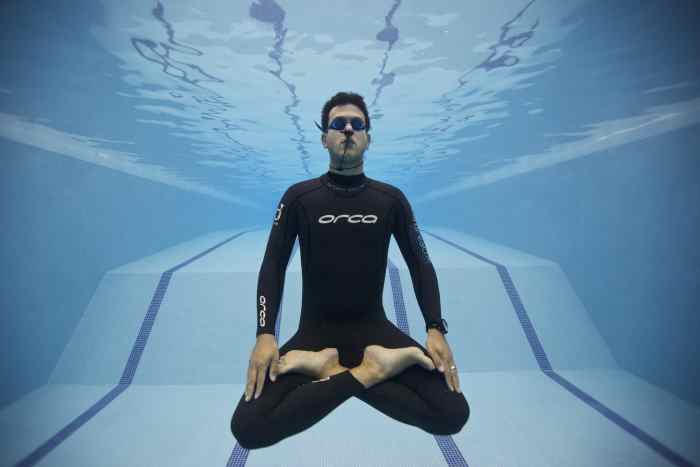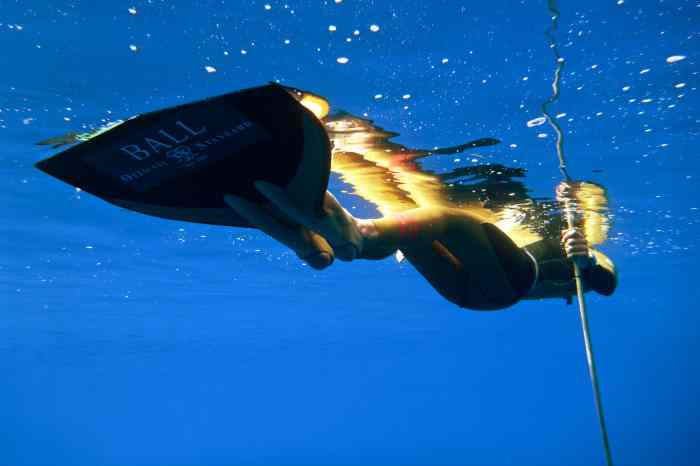- You are here:
- Home »
- Blog »
- Recommended Freediving Gear »
- Freediving Wetsuit vs Scuba Wetsuit: picking the right one is crucial
Freediving Wetsuit vs Scuba Wetsuit: picking the right one is crucial

If you’re thinking of investing in a new wetsuit for freediving, but don’t know the difference between a freediving wetsuit vs scuba wetsuit…then you’re not only setting yourself up for a pretty big financial mistake…
But also a mistake that could end up costing you a lot of bottom time and reducing your diving depths.
So what exactly then, is the difference between scuba & freediving wetsuits?
The main difference between a freediving wetsuit vs scuba wetsuit, is in how big the nitrogen bubbles are in each wetsuit.
Freediving wetsuits have large nitrogen bubbles, with thin neoprene rubber ‘walls’ resulting in a much thinner, yet warmer wetsuit. Scuba diving wetsuits have small nitrogen bubbles, with thick neoprene rubber linings resulting in a much thicker, cooler wetsuit.
Freediving wetsuits vs scuba wetsuits: a closer look
At this point you may be a little confused.
I certainly was when someone explained the structural differences to me.
After all – wouldn’t a thin wetsuit, much like a thin jumper, keep you less warm because there’s less distance between your skin and the cool environment?
Funnily enough, this is only partially correct. Sure – thickness of your wetsuit can keep you warmer in cold water…
But what counts more than the thickness of your wetsuit in keeping you warm: is the size of the nitrogen gas-filled bubbles trapped inside the neoprene rubber of your wetsuit.
The bigger the nitrogen bubbles in your wetsuit; the warmer your wetsuit will be in cold water.
Further to this: as the nitrogen bubbles in your wetsuit get bigger – less neoprene rubber gets used to make your actual wetsuit. This is why ‘thin’ (less dense) wetsuits are often warmer.
If you’re looking for the best freediving wetsuit for beginner/intermediate freedivers, I strongly recommend the Cressi Apnea.
This is an open-cell wetsuit which is of huge importance for freedivers (for flexibility and to help with deeper breath-holds).
The Cressi Apnea wetsuit has also been crafted with a very specific cut & material to lower friction and water resistance…you’ll notice there’s much less drag as it helps you jet through the water. Click here to check the price of the Cressi Apnea on Amazon.
Freediving wetsuits vs scuba wetsuits: how the difference affects your dives
Buoyancy:
Because freediving wetsuits are so thin, they are also less buoyant than scuba suits.
This is good for freedivers as the less buoyant your wetsuit is, the less weights you need to wear to descend (and drag back up again during your ascent!).
Scuba wetsuits on the other hand are thicker, so are more buoyant. This is the main reason freedivers avoid scuba suits. As a freediver you don’t want that extra drag, slowing you down while you descend.
Flexibility
A fantastic feature of freediving wetsuits is that because they are so thin, they are incredibly flexible.
Freediving with good flexibility is very important. The more flexible & agile you are underwater, the more comfortable you’ll be (leading to longer breath-holds).
A flexible wetsuit also helps with boosting your breath-hold, as it lets you inhale more oxygen.
If you use an inflexible scuba wetsuit, the suit will constrict your chest, lowering your total lung capacity/volume. This can reduce the amount of air you inhale by up to 1 litre (~0.25 gallons)!
- Side note: Is your weight belt made of nylon? If so, that too is probably ruining your pre-dive breathe up. Nylon is an inflexible material, and thus constricts your diaphragm as you inhale. I recommend investing in a rubber weight belt like this one here, as it will actually stretch as you inhale, leading to more oxygen & longer dive times.
Overall: freediving with a scuba suit tends to lead to shorter breath-holds with shallower dives – not to mention being a bit more sluggish in the water!

The flexibility of freediving wetsuits lets you inhale deeper breaths for longer bottom time.
Durability
Freediving wetsuits are thin, so are much less durable than scuba wetsuits.
If you’re a spearo, take care if you’re between rocks, so you don’t grind against them and tear your suit.
At the bottom of this post I talk a bit more about 2 good spearfishing wetsuits that are highly durable, you want to scroll down now and check it out.
Open Cell vs Closed Cell
A closed cell wetsuit is simply a wetsuit that has a polyester (or other material) lining on the inside. This makes it easier to put on but keeps you less warm.
Almost all scuba diving wetsuits are closed-cell wetsuits.
An open cell wetsuit is what freedivers love and use regularly. Open cell simply means that there is no interior lining on the inside of your wetsuit.
In other words: it’s just pure rubber against your skin. This not only helps the wetsuit fit tightly and very nicely against your skin to reduce drag…
But also keeps you nice and warm, just like a nice pair of neoprene gloves and socks.
One Piece vs Two Piece Wetsuits
Freediving wetsuits typically come as two-piece wet suits. You have the over-the-top first half of the wet suit. Then secondly, you have the bottoms which look like farming overalls (also known as ‘Farmer Johns’).
The reason for this is because freediving wet suits usually come as open-cell wetsuits, making them hard to get into because they are so tight (more on this later).
For this reason, a two piece wet suit makes it easier to get into, and also provides more warmth, flexibility and fits much, much better than a one-piece.
Scuba wetsuits typically come as one-piece wetsuits which results in them not being as tailored to your body as manufacturers aren’t able to do as a precise cut.
Zippers

Like the monofin; a freediving wetsuit is specifically engineered for speed and efficiency in the water.
Freediving wetsuits have no zippers, because zippers leak, add extra drag when finning and reduce flexiblity.
So if you’re a freediver, make sure to stay away from zippers – they are bad news! (they are very rare on freediving wetsuits for this reason)
However, because you have no zippers on your freediving wetsuit, getting into it can be a massive chore.
You’ll need to use either lube or conditioner to slide into the suit easily. I’ve also heard of divers using talcum powder, soap, corn starch or even a low-pH shampoo.
Unlike freediving wetsuits, scuba wetsuits come with zippers, making them much easier to get into (but also adding extra drag).
Pressure Differences
Remember how it’s the nitrogen bubbles, not the actual thickness of your wetsuit, that keeps you warm at surface level?
Well, as you go deeper underwater and as water pressure builds up…these nitrogen bubbles in your wetsuit get smaller and much worse at keeping you warm.
It gets to a certain point where the nitrogen bubbles do very little to protect against cold water. Instead, the thickness of your wetsuit is what keeps you warm.
This means that deep underwater, freediving wetsuits are worse than scuba wetsuits at keeping you warm.
But as a freediver, this is perfectly fine, as you spend almost no time deep underwater.
And if you are deep – you’ll be finning frantically to get back up again which keeps your body warm!
Scuba divers on the other hand, need a warm, thick wetsuit underwater, as they spend long periods at depth, moving very slowly.
Hoods
Unlike scuba wetsuits, freediving wetsuits come with hoods installed in the back of them. An incredible amount of heat is lost from your head – so a wetsuit hood really helps with keeping warm in cool climates (especially with keeping your ears nice and warm!)
Sometimes freediving wetsuits don’t come with hoods. In that case, you can always invest in a hood from Amazon (click here to check price).
When wearing a hood, you may also want to put a little bit of water in it before diving. This will help you equalize while wearing it, by stopping the air in the hood compressing and sticking to your ears during your dive.
To see a freediving wetsuit in action, check out the below Youtube Video from Body Glove:
Is it worth investing in a freediving wetsuit?
Yes, you should hands-down be investing in a freediving wetsuit, if you want to hit your full potential as a freediver.
A scuba wetsuit for freediving will only get you so far.
If you’re around other freedivers, and you’re wearing a scuba suit, you’ll stick out like a sore thumb.
You’ll find yourself getting frustrated with all the extra drag and discomfort that comes from diving with a bulky scuba suit; clunky zips, overly buoyant material and inflexible suit cuts that limit your finning style.
If you want to experience the complete serenity and feeling of ‘oneness’ with the ocean you hear so many freedivers talk about…
I strongly recommend investing in a freediving wetsuit.
Wearing a thin, sleek freediving wetsuit as you plummet to the bottom and race to the top again…feels amazing.
Not only does it massively boost your speed and agility in the water, but it’s also a huge confidence boost wearing a wetsuit that works WITH YOU (instead of providing extra dragging and holding you back).
If you’re a freediver, I recommend investing in the Cressi Apnea. The reason I recommend freedivers to use this wetsuit (or similar) is because it is an open-cell, with a very smooth, sleek design so you can RAPIDLY cover massive distances in the water.
Why the Cressi Apnea is the perfect wetsuit for beginner/intermediate freedivers
- Thinly cut: So you don’t have to fight against extra buoyancy during your descent with harder finning strokes (which burns through your oxygen reserves, killing your total bottom time)
- Large nitrogen bubbles & open-cell cut results in a nice, warm wetsuit…so you don’t waste energy on the surface shivering while you wait for your next dive.
- The open-cell cut of the Cressi Apnea means the raw rubber has a ‘suction’ effect onto your skin while you wear it.The end result is pretty crazy the first time you feel it…it’s almost like the wetsuit is just an extension of your body or a “second skin” as they call it…that turns you into a hydrodynamic torpedo slicing through the water! 😉
- Open-cell wetsuits are tight and highly flexible to assist with your flutter and dolphin kicking technique. Their flexible nature also assists with breathing deeply, so you can do your best pre-dive breathe-up before jetting down (for deeper dives).
- Two-piece wetsuit design: One big set back of open-cell wetsuits is that they can be hard to get into. This two-piece design makes it ALOT easier to get into your wetsuit (although you’ll still need to use a lubricant of some sort).
- Cost-effective: one of the main reasons I pick this wetsuit for beginner/intermediates is that it’s the best ‘bang for your buck’ wetsuit on the market. It comes with all the bells, whistles and features you want in a freedive wetsuit that will let you hit close to your full potential as a freediver…but still at a good price.
Disadvantages: One thing I will say about the Cressi Apnea is that it’s not very scratch/tear resistant up against rocks. So if you’re a spearfisher hunting crayfish among rocks in rough water, I’d invest in something with a little more padding.
But if you’re just a freediver, diving in open water, looking to experience the freediving fully and/or break depth records, the Cressi Apnea is the perfect wetsuit for you.
Click here to check the price of the Cressi Apnea on Amazon.
Wetsuit Thickness for Water Temperature

Rough guide for water temperature in Celsius vs Wet Suit Thickness
If you’re a spearo, you may want to invest in a closed-cell/scuba wet suit, like the Cressi Ultraspan.
It is a cost-effective, closed-cell scuba wetsuit. Because it’s closed cell – it’s incredibly durable (won’t tear when you’re chasing fish/crayfish between rocks – and protects against spikey fish defenses as you ascend back to the surface with your catch).
Click here to check the current price on Amazon for the Cressi Ultraspan.
Lastly, if you’re a spearo and you insist on wearing a freediving wetsuit (not a scuba suit), I recommend the neoprene SEAC BODY-FIT.
This spearo wetsuit is closed-cell (highly durable) yet very flexible with ‘smoothskin’ lining for a more hydrodynamic finning experience. As a spearo wetsuit, it perfectly hits that sweet spot between ‘speed’ and ‘durability’.
However, the main setback of the SEAC BODY-FIT, is that it’s slightly less durable than a scuba suit, because grazing against rocks can damage the smooth-skin lining.
Click here to check the current price of the SEAC BODY-FIT on amazon.
About the Author Gerrie van Niekerk - Apnealogy
Gerrie is a passionate Freediver, Spearfisher, Digital Marketer, and author for the Apnealogy website. Gerrie is an SSI Level 1 certified Freediver who loves geeking out about freediving and spearfishing gear and lives for his family and adventure.


